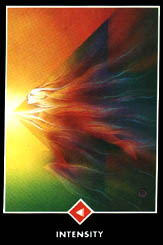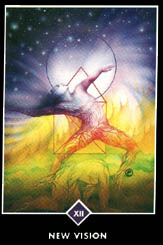The Osho Zen Tarot
A Deck Review
The Osho Zen Tarot is unique in a number of ways. Its approach to the Tarot
is not based on predicting the future, but on finding spiritual insight and
guidance through "the transcendental game of Zen". It does not - as some
decks have done - alter the structure of Zen to suit the Tarot, but instead
it alters the structure and meaning of the deck to reflect the philosophy
from which it is derived. But these changes do not detract from the deck in
any way. If possible, the alterations made by the artist make the final
product even more powerful than a standard Tarot deck.
The images on the Major Arcana of the Osho Zen deck are nothing short of
spectacular, and though the Minor Arcana are generally less complex in both
quality and imagery, they are still very deep images - as one would expcet
from a Zen deck. It's rare to see a deck which does not just display the
Rider-Waite images in different perspectives and colors, and in this respect
the Osho Zen shines. One can literally meditate on these images for hours.
Cards such as the Five of Rainbows and the Eight of Water express the same
general themes as their equivalents in other decks, but with the kind of
simplicity and elegance that only Zen can provide.
 Yes, the suit names have been changed - Wands are Fire, Cups are Water,
Swords are Clouds and Pentacles are Rainbows. And this is not the only
immediately visible change to the structure of the Tarot. The court cards
have no ranks, being replaced instead with words such as "Intensity" for
the Knight of Fire and "Control" for the King of Clouds. The majority of
the Major Arcana have been renamed - only the Lovers and the Fool retain
their traditional title. A numberless twenty-third Trump called The Master
has been added to provide a way out of the cyclic Fool's Journey.
Yes, the suit names have been changed - Wands are Fire, Cups are Water,
Swords are Clouds and Pentacles are Rainbows. And this is not the only
immediately visible change to the structure of the Tarot. The court cards
have no ranks, being replaced instead with words such as "Intensity" for
the Knight of Fire and "Control" for the King of Clouds. The majority of
the Major Arcana have been renamed - only the Lovers and the Fool retain
their traditional title. A numberless twenty-third Trump called The Master
has been added to provide a way out of the cyclic Fool's Journey.
But as I said before, these changes are only detrimental if you are not open
to new ways of experiencing the Tarot. And while there is a visible Oriental
influence in the images and meanings of these cards, one does not have to be
a follower of Zen to appreciate what has been created here. The only real
drawback about the Osho Zen deck is that doing divination readings with it
can be challenging, especially if you use "traditional" interpretations. The
only real way to do a divination with this deck is to use the rich symbolism
as a jumping-off point for your own intuition. But as a tool for meditation
and guidance, Osho Zen has few equals.
This deck does not come with a little white booklet, which is fortunate since
there is no possible way to cram all of its wisdom into such a pamphlet.
Instead, the deck is packaged with a 176-page book that contains, for each
of the 79 cards, a page of interpretation and an excerpt from one of Osho's
books as a meditative aid. The book also contains some history (most of
which is sadly inaccurate, and I suppose that is the only flaw I shall find
with this wonderful deck) as well as a number of very useful spreads and a
glossary of symbols.
 I highly recommend the Osho Zen Tarot to readers of all skill levels and
spiritual backgrounds. The philosophy of Zen is equally accessible to all
and that is part of what makes this deck so powerful. The quality of the
artwork is such that some collectors may want it for the images alone. But
regardless of whether you use it for divination, meditation or spiritual
insight, this deck is guaranteed to change the way you think about Tarot.
That is its true power.
I highly recommend the Osho Zen Tarot to readers of all skill levels and
spiritual backgrounds. The philosophy of Zen is equally accessible to all
and that is part of what makes this deck so powerful. The quality of the
artwork is such that some collectors may want it for the images alone. But
regardless of whether you use it for divination, meditation or spiritual
insight, this deck is guaranteed to change the way you think about Tarot.
That is its true power.
Copyright 2000 James Rioux
 Yes, the suit names have been changed - Wands are Fire, Cups are Water,
Swords are Clouds and Pentacles are Rainbows. And this is not the only
immediately visible change to the structure of the Tarot. The court cards
have no ranks, being replaced instead with words such as "Intensity" for
the Knight of Fire and "Control" for the King of Clouds. The majority of
the Major Arcana have been renamed - only the Lovers and the Fool retain
their traditional title. A numberless twenty-third Trump called The Master
has been added to provide a way out of the cyclic Fool's Journey.
Yes, the suit names have been changed - Wands are Fire, Cups are Water,
Swords are Clouds and Pentacles are Rainbows. And this is not the only
immediately visible change to the structure of the Tarot. The court cards
have no ranks, being replaced instead with words such as "Intensity" for
the Knight of Fire and "Control" for the King of Clouds. The majority of
the Major Arcana have been renamed - only the Lovers and the Fool retain
their traditional title. A numberless twenty-third Trump called The Master
has been added to provide a way out of the cyclic Fool's Journey.
 I highly recommend the Osho Zen Tarot to readers of all skill levels and
spiritual backgrounds. The philosophy of Zen is equally accessible to all
and that is part of what makes this deck so powerful. The quality of the
artwork is such that some collectors may want it for the images alone. But
regardless of whether you use it for divination, meditation or spiritual
insight, this deck is guaranteed to change the way you think about Tarot.
That is its true power.
I highly recommend the Osho Zen Tarot to readers of all skill levels and
spiritual backgrounds. The philosophy of Zen is equally accessible to all
and that is part of what makes this deck so powerful. The quality of the
artwork is such that some collectors may want it for the images alone. But
regardless of whether you use it for divination, meditation or spiritual
insight, this deck is guaranteed to change the way you think about Tarot.
That is its true power.